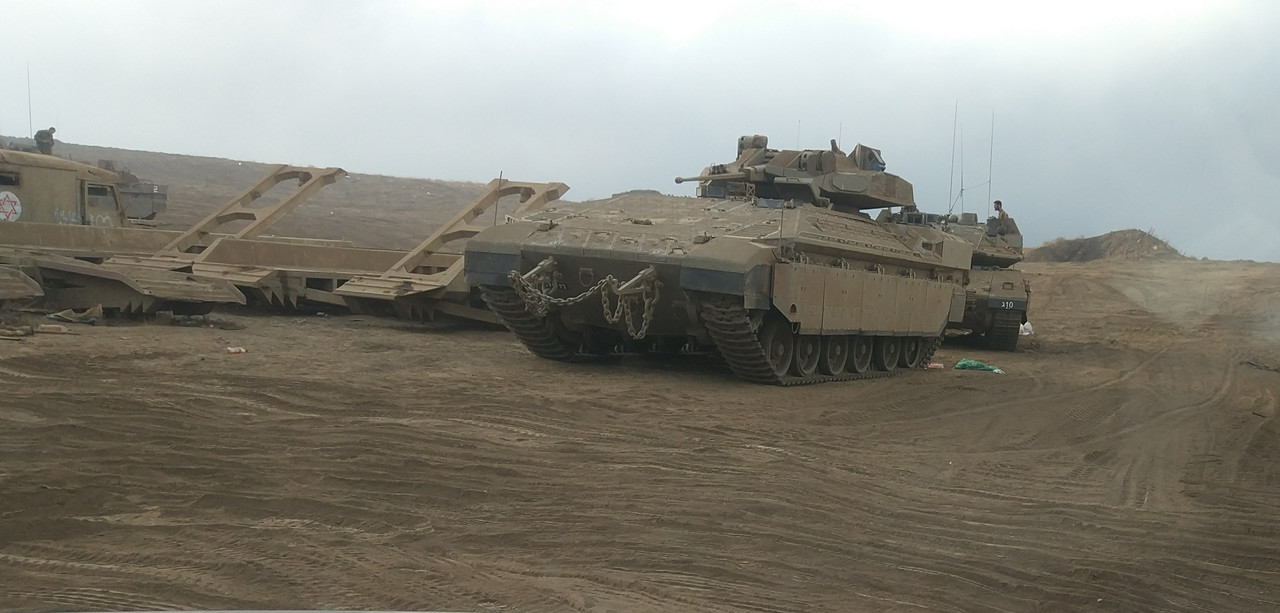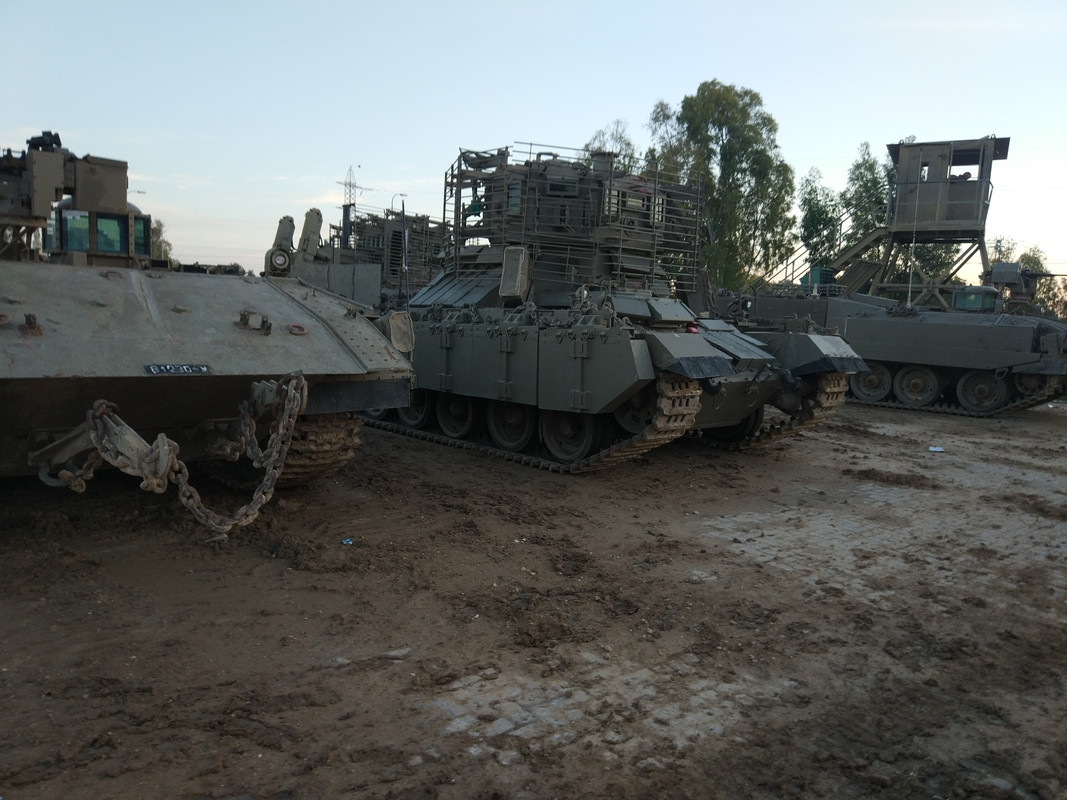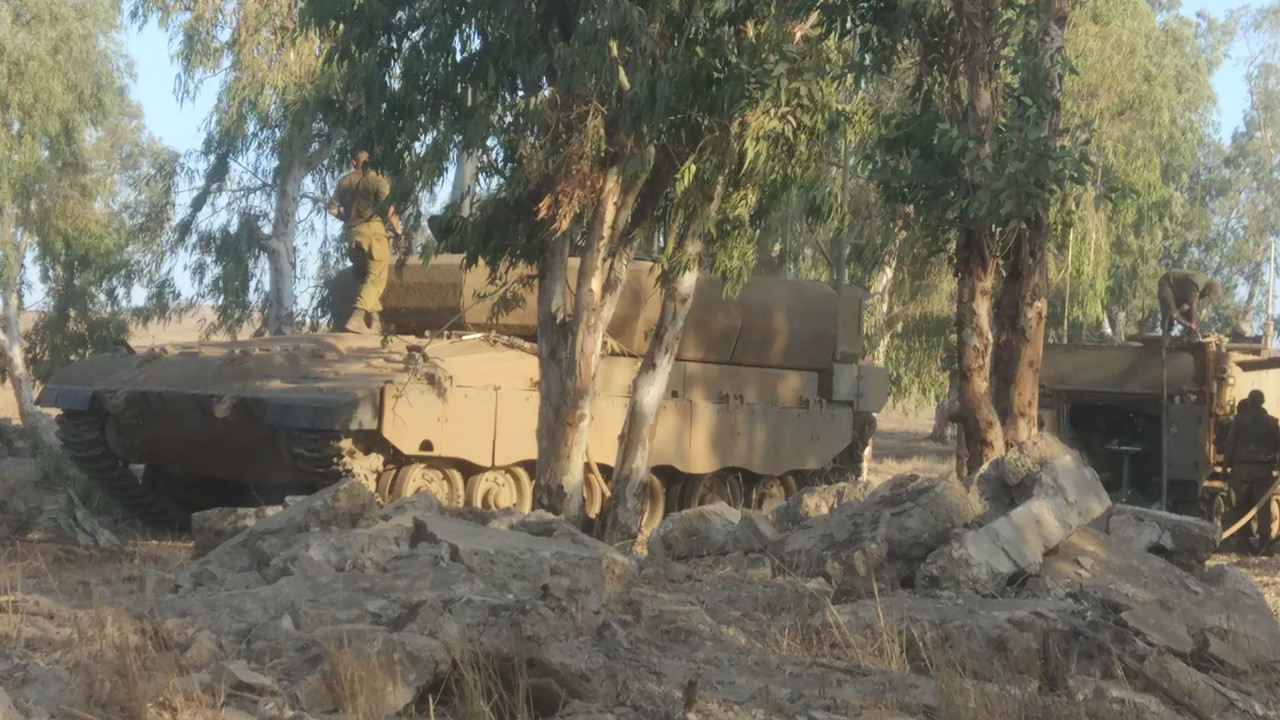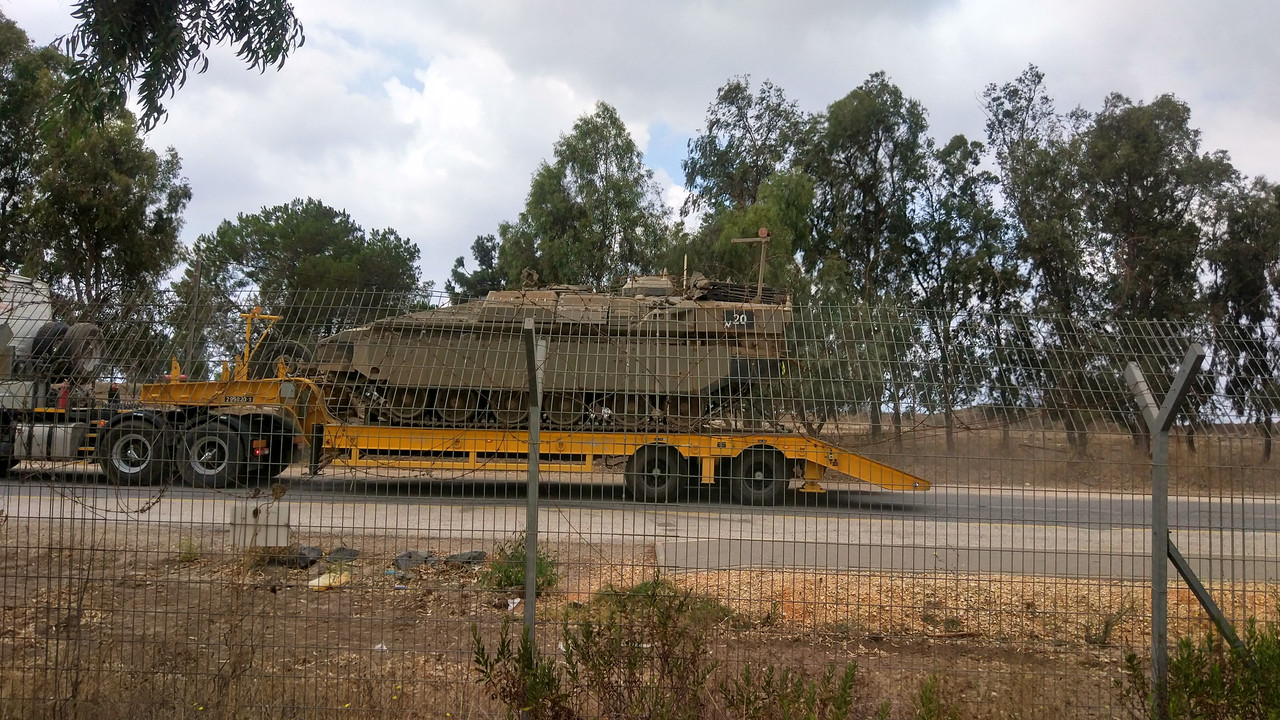-
Posts
21 -
Joined
-
Last visited
-
Days Won
1
Content Type
Profiles
Forums
Blogs
Gallery
Downloads
Events
Posts posted by Lox
-
-
-
-
9 minutes ago, Mighty_Zuk said:
I think I lost you, are you suggesting the Ofek is based of the Mk3? In what pic can you see it's serial number?
-
1 hour ago, Mighty_Zuk said:
Perhaps it'll get better armor on the superstructure, but I'm not too sure what to think about a Merkava 2 used as a CP vehicle. I don't see why it's hard to allocate 1 vehicle out of 100 for command (brigade level), by using a Mark 4 chassis, with a Trophy and all.
Golani do that, I've posted one of them on a trailer a while back, tho I don't think they have trophy on them
-
8 hours ago, VPZ said:
Does it have Merkava-like or Namer-like rear hatch?
Something bigger than both it seemed, and the style was more so Namer-like,
7 hours ago, Serge said:It’s possible because some Ofek have heavily rebuilt rear with a high opening compatible with APC ramp.
Large doors are important for CP because the staf spends many times outside of the vehicle. Very of often, you need to talk to someone inside staying outside. So, the CP while static, keeps its doors open.
You must close the ramp at nighttime because, at night, lights attract problems more than noise.
This guy knows
17 minutes ago, Newtonk said:Thank you, Lox, most intriguing. From a strictly modelling perspective, what does the roof look like, please? Thank you.
Sadly idk, sorry I feel like a tease, but I wasn't gonna climb on top of it in the middle of thier exercise xD
I've also came across this fella

-
5 hours ago, Mighty_Zuk said:
Noice. Then what's behind the Ofek? Some new M113 variant?
And any idea what new stuff they put on the Ofek other than Satcom?
Just a nagmash pikud, a quick Google search tells me it's called M577 in english as someone said.
I didn't go inside the Ofek for obvious reasons, but from what I've seen it looked nothing ground breaking just a heavier nagmash pikud. I know littile of command APCs to be honest.
The guy in the pic is trying the refuel the damn thing, considering the two back refueling ports are gone due to the superstructure, it took him some time xD
-
2 hours ago, Mighty_Zuk said:
Where did you get this one?
I took it

-
-
-
12 hours ago, Karamazov said:
it's a Zelda 2, am I right?
I don't think so, it is a zelda, but it's fucking weird
-
-
On 5/11/2018 at 5:59 PM, Mighty_Zuk said:
On the 15th to 16th of May, a ground warfare conference will be held in Israel, where among the topics there will be a debate about future AFV programs in the IDF. It's not going to give it as much focus as there was in last year's conference, but I expect we will get a (relative) wealth of new details about the current running projects:
- Barack MBT
- Eitan AFV
- Namer AFV
- New howitzer (yet unnamed)
- Carmel
- An up to 8 ton light AFV to replace the M113 in some utility roles, and perhaps even some HMMWV.
I do not expect as many details as we got last year, and most will likely be repeated. But here is a small list I made of details that we still need to know about these projects, that weren't talked about in a long time.
- Barack - Will it receive a new engine? Is it on schedule? Were the HMD tests successful? What is the status of the APS development? Will it have additional upgrades to the non-active armor, gun, or other internal structural changes?
- Eitan - At what point will it be prioritized to get the next gen tech to replace current gen? i.e hybrid instead of diesel, next gen APS instead of current Trophy.
- Namer - When will it receive the new turret? When will it receive a new engine? And if it does get a new engine, would it be spare GD883 from Merkava 4, or the new hybrid engines of the Barack (if it does get them)?
- Howitzer - When will it enter service? Is there going to be a tracked version for maneuvering warfare?
- Carmel - Is there any progress with the bid for the cockpit design?
- Light AFV - What will its designated purpose be?
- 30mm turret - At what point will it be integrated with the next gen Trophy APS instead of current one?
What's it called and where I can I see live coverage of it?
-
On 3/30/2018 at 2:07 PM, Mighty_Zuk said:
Israel's artillery-oriented magazine shared an interesting article by Lt Col Rafi Almagor that shares insights from the past development of the Sholef, that could be implemented in the development of the new, yet-unnamed howitzer in development.
Lt Col Rafi Almagor was one of the heads of the Sholef program.
The article is in Hebrew and translated to English by me:
Development of the future self propelled howitzer of the artillery corps, one of the main projects of the ground arm, began last year in the company Elbit Systems. This isn't the first time Elbit's plant in Yokneam develops a howitzer for the IDF. In fact, in the days of Soltam, in the 80's of the last century, a new howitzer was developed under the name "Sholef". That project did not materialize to serial production, but the technology of the Sholef and its development technique were studied and implemented by German companies for the sake of the development and manufacturing of the Panzer 2000 howitzers, sold across the world.
The demand to develop the Sholef came after the Yom Kippur War, tells Lt Col Rafi Almagor, that served as the head of the development department.
At the time, there were only 2 battalions of the Rochev (M109A5), that was the best howitzer in the corp. All the other howitzers were either towed or self propelled, but even the self propelled ones were almost like towed ones, for example the M-50 (Sherman based L-33 cannon).
The requirement was for a cannon that was better propelled, with higher rate of fire, with longer ranges, and better protection. After a long round of debates it was decided that the Sholef project would be based on the Merkava and handled by MANTAK (Merkava Tank Administration).
The idea was to developed a turret that is all artillery, and on the other hand use an existing hull that was developed for the Merkava. The Merkava was suitable because its engine was in the front. At the time, the idea to put the M-50's engine at the front was revolutionary and allowed converting a tank hull to a howitzer's hull. In essence, it was the beginning of the conception of a universal platform for all corps.
The Sholef's characteristics included among other things a 52 caliber gun, a range of 40km and a high rate of fire of 9 rounds per minute. The cannon included a semi-robotic system, meaning the shells were moved by a robotic system, and the charges were moved manually, because at the time it wasn't known where the future of charges would go - liquid, modular, or electro-magnetic. Thus, the line of thought was that we need to be prepared for everything. Additionally, for the Sholef to be more available in all combat scenarios, improvements were made tot he protection, and means against bomblets, shrapnel, and small arms fire were added.
In his opinion, similarly, the development of the new howitzer requires creative thought that would provide a long term solution.
In the framework of development you have to understand 2 things:
1)You never really know what they'll demand of you in the end.
2)When you have a good weapon that can move everywhere, outranges everything, and can fire in direct firing mode - you can do special things during combat that the enemy won't expect.
That's what accompanies me all the time when I think about the future howitzer.
During his time in the project, Almagor commanded on the team that did the field testing. In his opinion, if the Sholef was operational, it would still be a world leading howitzer. In the end, it didn't become operational, but its demonstrators have shown impressive capabilities in all parameters - firepower, mobility, and protection.
Now that he's aware of the development of the new howitzer, he asks the new development team to learn from his experience.
According to media releases, the demonstrator that Elbit develops will be based on the ATMOS, but will be better and more innovative, explains Almagor.
The ammunition handling system will be fully robotized; From the automatic loading of the fuze, the modular charges, the loaded shell, and the firing - all will be done without human intervention. The soldiers will be in the cabin, as is in the MLRS today. They will input all the data to the mission computer, and the howitzer will commence the loading and firing sequence automatically. This is an innovative approach that shows technological advancement. In comparison with the tools we have today, we understand that the new howitzer will bring an improvement in almost every parameter. What interests me is if the howitzer will provide a long term solution, or are we settling for what is trendy in today's market?
I learned about the importance of mobility only through the Sholef, and my insistence on the Merkava. In one of the exercises in the Golan we ran into a tactical problem when the Sholef was stationed in Katzrin, and the exercise itself was in Yosifon. About 6 hours before the drill, when the howitzer was ready in position, a safety directive was received, according to which, we couldn't conduct the firing as planned, and they were about to cancel the artillery support. The section commander received a path, and through the inertial navigation system, the Sholef 'cut' through the Golan Heights with the Merkava's treads, and arrived at peak speed in the staging zone of the assault forces.
Meaning, the Sholef's mobility allowed it to conduct this unexpected move and managed to prevent the abortion of its participation in an exercise.
During my work with the Sholef, I ran into many cases where the Rochev (M109A5) had trouble going through certain terrain, whereas the Sholef wasn't bothered by it.
During my days as an instructor in a battalion commanders' course, I witnessed how better the mobility of the Merkava was compared to the other AFVs that were there, in every terrain. Even good artillery will be required to do some unexpected actions.
We had a few exercises when the Sholef was driving alongside the tanks to solve a certain scenario in a very 'special' terrain conditions. Had it not had the tracks that allowed it to 'sprint' with the tanks, and the large belly (ammo storage), it would have been a significant disadvantage. So the mobility allows me to go 'wild' on the battlefield and do things the enemy wouldn't expect me to be able to do.
It's obvious the new howitzer will be much better than the Rochev, but it's important to see how limited it will be in certain conditions.
Another important aspect in the conception of the new howitzer is its firing and loading systems, with emphasis on their reliability. In the technological age of today, Almagor explains, automatic systems are far more reliable than they were in the Sholef's days, and they know how to locate and analyze almost any fault. With that in mind, we need to be careful so that technology wouldn't dictate our actions and cripple our forces when the reported faults don't need the reality on the field.
When we asked Aviel to insert new capabilities, we had to make sure that the addition brings an operational advantage, and that we control the technology and not it controls us, he adds.
When we're talking about weapon systems, the ability to override the automatic systems is critical. That is, I must be able to tell the robot "I understand you, there's a problem but keep going". In the Sholef we dedicated a lot of thought into that. If the robot tells you, for example, that there's no shell in the barrel, but you can see that there is, and there's a problem with a small sensor - does the commander have the ability to override the problem and continue the mission, or should the whole system be shut down?
Will the howitzer only work when it's 100%? Or will it work when there are malfunctions? All this needs to be considered. Even if today's systems are more reliable sevenfold, the new howitzer will be 20 times more complex, and thus the expectancy of malfunctions will not reduce.
In the battlefield, the howitzer is of course more exposed to dangers than sand and mud. Almagor identifies the aspect of self defense as a potential weakspot. Historically, we can put less emphasis on protection because few are the times when we're hit with counter-battery fire. But whoever fears counter-battery and wants to increase his range, deploy on larger areas, and quick movements after firing, must also provide an answer against short range shrapnel, small arms fire in case of commando attack, and protection of the charges' bin.
I think the new howitzer must have means of self protection for the crew. Whether it is machine guns, a mortar, or other means. The howitzer cannot be dependent on another protective force.
From my experience, I'd recommend it have a few minimal protective capabilities. In the Sholef we had 2 machine guns on the roof that provided us great protection against infantry. We pondered whether to add a mortar like they had in the armored corps - but we didn't adopt the idea in the end.
According to the media, the new howitzer will present improved rate of fire, that will allow few vehicles to provide high concentrations of fire with high accuracy. In Almagor's opinion, in order to have a high rate of fire, the the importance of the belly (ammo storage) is critical.
Other than having just a wide belly that will allow a large number of shells that will support a high number of missions, a high variety of types of shells is also important. A howitzer with many shell types will be more flexible.
Today's developments in the artillery world present a high variety of innovative ammunition. With that in mind, there also needs to be the capability to fire old types of ammunition. If we look at the military history of Israel, it seems that in every lengthy war we had to receive support from friendly states in order to refill our ammo stocks. So that the importance of backwards compatibility is significant in this regard.
Another aspect of the ammunition belly is the 'ground shells' (shells provided by the ammo carrier that are usually just dropped on the ground near the howitzer) . At the time we thought the Sholef should fire these. That is, if I am in a safe position, it's best I fire these before I start consuming my internal ammo, and only consume it when I maneuver. I suggest the developers look into this aspect as well.
Is there a digital version of the Hebrew original?
-
-
3 hours ago, Byakuya Ai said:
Do you or anyone know these AFVs turret's armor thickness?
Sry but no
-
That might be housings for antennas, although it doesn't look like the usual
-
-
-
1 hour ago, Zyklon said:
Welcome to SH old friend!
 7 minutes ago, Belesarius said:
7 minutes ago, Belesarius said:Welcome to SH.
Ty ya'll
-
A bit more historically themed - a Magach (6?) Of the 46th battalion during the 1982 Lebanon war sporting dual coax 50 cals

- Belesarius, Mighty_Zuk and Zyklon
-
 1
1
-
 2
2












Israeli AFVs
in Mechanized Warfare
Posted